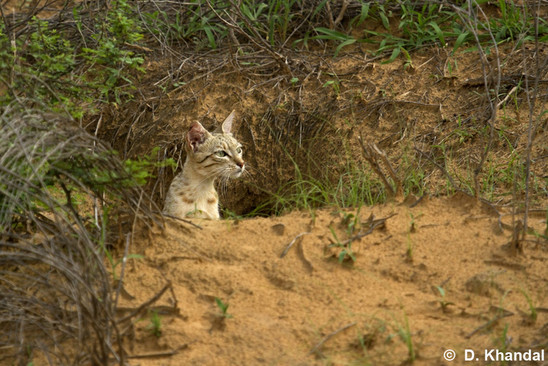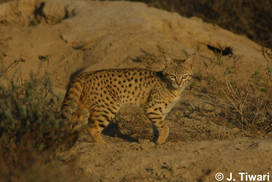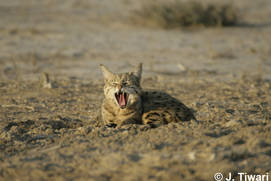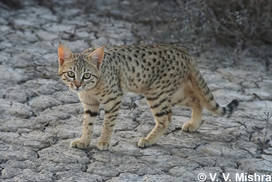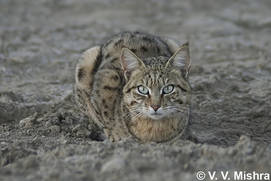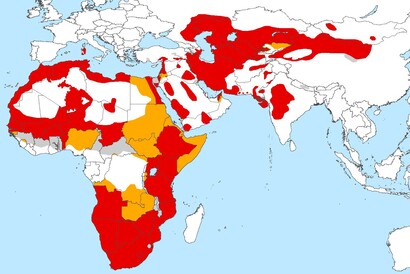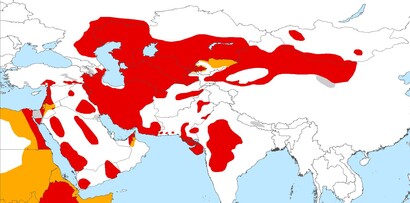Asiatic wildcat
Felis lybica ornata
IUCN Red List: NA
Felis lybica
IUCN Red List: LC
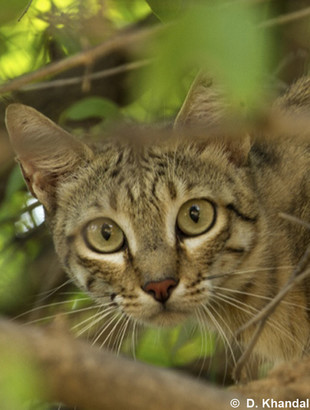
| Weight: | 2-7.7 kg |
| Body length: | 40.6-64 cm |
| Tail length: | 21.5-37.5 cm |
| Longevity: | up to 11 years |
| Litter size: | 2-4 cubs, rarely up to 8 |
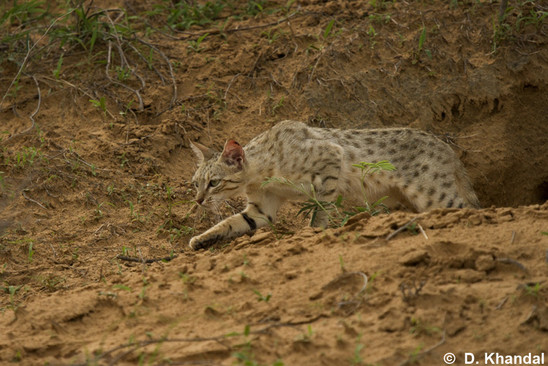
Description
The revised taxonomy of the Felidae provisionally recognises the following species of the Genus Felis: Felis chaus (Jungle cat), Felis nigripes (Black-footed cat), Felis margarita (sand cat), Felis bieti (Chinese mountain cat), Felis silvestris (European wildcat), Felis lybica (African wildcat) and Felis catus (domestic cat). The Asiatic wildcat (Felis lybica ornata) is considered as a subspecies of Felis lybica and inhabits South-West and Central Asia, Afghanistan, Pakistan, India, Mongolia and China.
The Afro-Asiatic wildcat is smaller than the European wildcat and its fur is more yellow or reddish in colour with characteristic small black or reddish-brown spots and sometimes stripes. Its fur colour varies from region to region with paler coloured individuals living in dryer areas and darker more heavily spotted and striped individuals in more humid areas.
Language/Country | Name |
|---|---|
Afganistan (Dari) | psk dsty |
Chinese | ye mao, caoyuan ban mao |
English | Asian steppe wildcat |
French | chat sauvage d'Asie, chat orné |
Georgian | velis cata |
German | Asiatische Wildkatze, Steppenkatze |
India (Kutch) | jhang meno |
Iran (Farsi) | gorbeh yahhshi |
Kazakh | myshuk dala, jawa misik |
Kirgiz | matsyl, zhapayi mishik |
Mongolia | tsookhondoi |
Russian | asiakiya dkikaya, stepnaya koshka, dlinahvostaya koshka, pyatnistaya koshka |
Spanish | gato montés, gato silvestre |
Uygur | yawa müshükl |
Uzbek | choi pshak, sabancha, yobai pshak |
Status and Distribution
The Afro-Asiatic wildcat is considered as Least Concern in the IUCN Red List of Threatened Species. The status of Felis lybica ornata is not very clear and recent population estimates are missing. Due to its cryptic behaviour and its hybridization with domestic cats, it is difficult to assess its status. In the central parts of its range, in the lowlands of Kazakhstan, the population of the wildcat was reported to be stable in 1993. It has been photographed recently in Afghanistan, Armenia, Iraq and Tajikistan, but its status in those countries is still unknown. In Iran, the species occurs in a variety of habitats throughout the country (apart from Caspian forests).
The Afro-Asiatic wildcat has a very wide distribution, found throughout most of Africa, southwest and central Asia into India, China, and Mongolia. The wildcat is widely distributed from the Caucasus and Turkey to western India, northward to Kazakhstan, western China and southern Mongolia. In Iran, it was found in 27 of the 31 provinces. It was absent from the northern provinces Gilan and Mazandaran dominated by Hyrcanian forest, and from Alborz and Qom. India is the south-eastern border of the wildcat’s range and its occurrence is reported from the drier areas of west and central India. There are some reports of phenotypic wildcats from various locations in Nepal. However, this preliminary evidence still requires confirmation from genetic or craniometrics studies.
The western extent of the Asiatic wildcat distribution is unknown. It has been suggested that Felis lybica ornata, Felis silvestris and Felis lybica lybica divide in the region of Iran, Turkey and the Caucasus. However, recent camera trap pictures from Armenia, western Iran, Eastern Turkey and Kurdistan Mountains in Iraq reveal a common coat pattern, suggesting that the division of the European wildcat and Felis lybica lybica and Felis lybica ornata might occur further west. A genetic study of wildcats in Iran indicates this country to be the separation area between F. l. lybica and F. l. ornata, but found no individuals of European wildcats. Comprehensive genetic analyses are required to map the distribution of Felis lybica ornata in Southwest Asia.
Habitat
The wildcat occurs in a wide variety of habitats. It can be found mostly in scrub deserts, up to 2,000–3,000 m elevation, mountainous areas with sufficient vegetation, as well as temperate forests. It avoids vast deserts, dense forests and deep snow. The wildcat usually occurs close to water sources but can also live in low-water areas. It does not seem to avoid cultivated areas and human settlements.
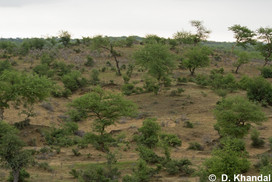
- Habitat of the Asiatic wildcat in India.
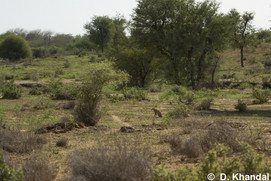
- Asiatic wildact in its typical habitat, India.
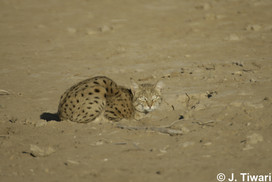
- Asiatic wildcat hunting for rodents, India.
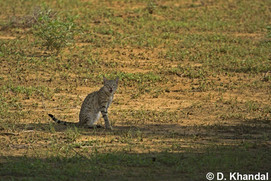
- Asiatic wildcat, India.
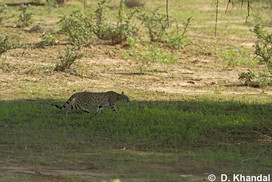
- Asiatic wildcat, India.
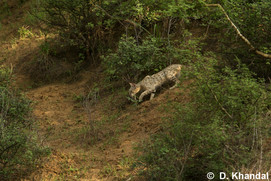
- Astiatic wildcat on the way to its burrow, India.
Ecology and Behaviour
The wildcat is mostly nocturnal but can also be observed during daytime. It hunts on the ground and yet is a very good climber. It hunts its prey by stalking followed by a quick attack. The mother teaches her cubs to hunt by providing them injured prey individuals or by giving them beetles and the eggs of ground dwelling birds. The wildcat rests and dens in burrows. It is a solitary and territorial species. Home ranges of males and females are recorded from 1.7 – 51.2 km², depending on habitat and prey abundance. Density estimates range from 0.7 - 10 individuals per km².
The mating season seems to vary according to the range. In India, the mating season has been recorded to be from March to April and from November to December whereas in Central Asia it took place in January to February. In Pakistan, the mating season seems to be year round. Litter size is usually 2 – 4, rarely up to 8. The gestation lasts for 56-68 days and age at sexual maturity can be at 9 - 12 months but first breeding probably takes place at 18 - 22 months.
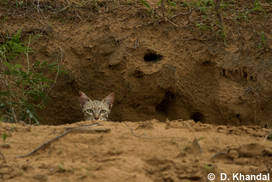
- Asiatic wildcat looking out from its burrow, India.
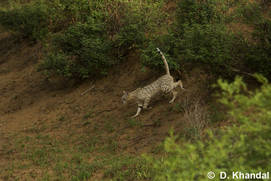
- Asiatic Wildcat, India.

- Asiatic wildcat cleaning its paw, India.
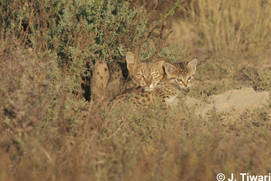
- Female Asiatic wildcat with its kitten, India.
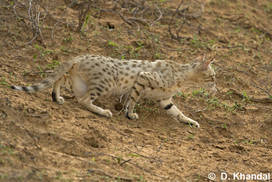
- Asiatic wildcat hunting for prey, India.
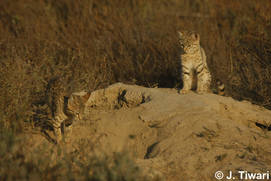
- Asiatic wildcat kittens playing, India.
Prey
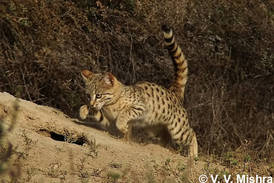
- Asiatic wildcat kitten hunting, India.
The main prey species of the Asiatic wildcat, as for all wildcat subspecies, are rodents such as jerboas, gerbils, voles and mice. Occasionally, it also takes birds, amphibians, insects, lizards, snakes or even hares. In Uzbekistan, the wildcat also predated on a nest of the Turkestan ground-jay. The wildcat also sometimes scavenges food, or preys upon poultry and small livestock.
Main Threats
As all wildcat subspecies, also the Asiatic wildcat is threatened by domestic cats. Hybridisation with domestic cats can lead to the loss of genetic information and is thought to be one of the main threats. Hybridisation was reported from Pakistan and Central Asia and is most likely also a problem in India. There may be very few genetically pure populations of wildcats remaining. Feral domestic cats also compete for food with the wildcat and can transmit diseases to it.
Another important threat is from poaching related to conflict with humans. Wildcats are reported to kill small livestock and poultry and hence are reported being trapped, poisoned, killed by shepherd dogs or directly poached by humans in Iran and probably other parts of its range. Road mortality can be high in certain areas. In the past, the wildcat was trapped in high numbers for its fur in several areas such as Kazakhstan, China, India and Afghanistan. In 1979, traders in India declared stocks of 41,845 furs of wildcats for an export amnesty. Presently, there is little international trade in wildcats, but pelts still show up in local markets throughout the range. Also, habitat destruction and reduced habitat quality remain important issues. The wildcat is under heavy pressure due to land use changes. In Azerbaijan and India habitat loss has been documented and in India, its population is possibly declining fast. Rodenticides and other chemicals may also threaten it as well as incidental killing e.g. in snares set for other species.
Conservation Efforts and Protection Status
The wildcat is included in Appendix II of CITES and is fully protected across most of its range in Asia. Hunting and trade are prohibited in India and Pakistan. In Afghanistan, the wildcat was placed on the country’s first Protected Species List in 2009. All hunting and trading of the species is prohibited and it is proposed as a priority species for future research. In Armenia, China, Kazakhstan, Kyrgyzstan, Tajikistan, Turkmenistan and Uzbekistan, hunting and trade is regulated. In Georgia, Iran and Mongolia it is not legally protected. No information is available for Azerbaijan, Iraq and Turkey.
There is an urgent need for more information about the status and distribution of the wildcat as little information is available and its population size and status are largely unknown. It is likewise important to identify genetically pure populations and to prevent hybridisation with domestic cats. Also, mapping the distribution of this subspecies using genetic sampling is of high priority.
